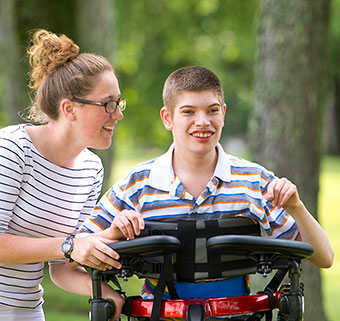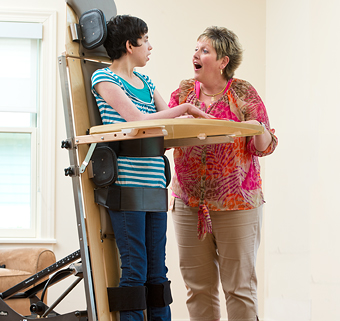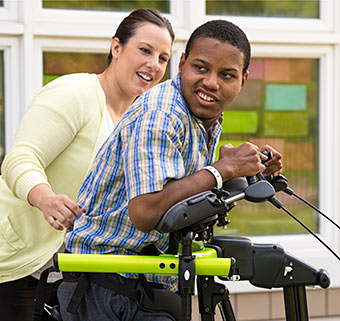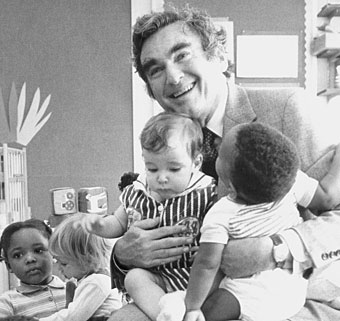Advocacy for Cerebral Palsy
A Parent Interview
| June 2018 Recently, Rifton caught up with Michele Shusterman, mother of Maya and founder/president of CP NOW, a cerebral palsy nonprofit. CP NOW provides educational and support resources to the CP community and funds new research ideas. Although newly formed, CP NOW is gaining recognition and receiving accolades from families, professional organizations and CP centers throughout the US, particularly for their CP Tool Kit, a diagnosis resource guide for families. We thought her insights were valuable and wanted to share them with you.
Recently, Rifton caught up with Michele Shusterman, mother of Maya and founder/president of CP NOW, a cerebral palsy nonprofit. CP NOW provides educational and support resources to the CP community and funds new research ideas. Although newly formed, CP NOW is gaining recognition and receiving accolades from families, professional organizations and CP centers throughout the US, particularly for their CP Tool Kit, a diagnosis resource guide for families. We thought her insights were valuable and wanted to share them with you.
As a parent, what do you consider most important for society to know about the diagnosis of cerebral palsy?
Cerebral palsy (CP) hasn’t received nearly as much public exposure as other health conditions though it is the most common cause of physical disability in children. It also affects a large adult population. I have run into many misconceptions about CP, from assumptions that everyone with CP uses a wheelchair to people attributing cognitive limitations to people with physical impairments and communication difficulties. While some people with CP have intellectual impairments, others are lawyers, doctors, teachers, and therapists. And at least one I know of is a neuroscientist studying CP!
CP simply means that an individual of any age has had a very early neurological disturbance that permanently affects the person’s ability to initiate and coordinate movement. The boundaries of the neurological injury aren’t necessarily limited to movement. CP may affect different systems of the body such as vision, hearing and communication, but CP is often recognized and discussed first as a set of movement disorders.
How do you believe that the term “early developmental brain injury” rather than “cerebral palsy” could potentially improve clinical care and policies?
I wrote an opinion piece published in Developmental Medicine and Child Neurology that emerged from my frustration as a parent fighting to understand what the term “cerebral palsy” meant. So often CP is discussed in terms of its movement disorders (i.e. spasticity, dyskinesia and ataxia), but the boundaries of injury or disturbances in neurological development aren’t so cleanly delineated. Areas of the brain outside of motor function may often be affected (as mentioned above) and impact the individual’s daily life.
Over time it dawned on me that cerebral palsy was basically a brain injury but is seldom explained that simply. So calling CP an early development brain injury gives parents an easily understood context for their child’s condition. It also sets them up for being more successful in accessing services, support and timely treatment for their child. Clinicians may also become immediately aware of the need for comprehensive surveillance and early intervention referrals rather than the former practice of watching and waiting. Finally, reframing cerebral palsy and placing it on a continuum with adult brain injury will improve its visibility among the public and with policy makers.
Do you think there is a growing understanding of neurorecovery and wellness as essential components of cerebral palsy care and intervention?
We are certainly seeing more hopeful language and standards of care for the CP community being articulated by leading researchers and professional organizations like the American Academy for Cerebral Palsy and Developmental Medicine (AACPDM). Ten years ago many clinicians would have balked at the idea that much of anything could be done to improve outcomes of people with CP. And it wasn’t so long ago that researchers learned that strength training is actually helpful rather than harmful when you have spasticity. Thanks to parent advocacy, research efforts of other neuro communities and advances in our understanding of neuroplasticity, professionals have begun thinking much differently about CP. The key now is to facilitate access to adaptive programs and other opportunities for our community to maintain their health and wellness. We also need to have a better understanding of how CP changes over the lifespan and what interventions and health and wellness programs are important to implement at different points in time.
What are the routes that have proven effective in your experience for obtaining adaptive equipment for the home?
I never take no for an answer—at least the first couple of times! I realize that parents are pressed for time and energy but more than anything else, relentless communication and persistence with insurance companies has proven effective for us. We aren’t always successful, and it’s getting increasingly harder to get insurance approvals, but I have lost count of the number of times we have had a “firm NO” from insurance overturned. It has also been invaluable for us to collaborate with Maya’s pediatrician, physical therapist and equipment vendor to strategically present Maya’s needs in a way that are compelling, practical and critical to supporting her health and wellness. We make sure the person reviewing our request immediately understands and can connect with Maya as a person (sometimes we even send in a photo) and not just another claim number.
How can families and clinicians advocate for or contribute to research efforts for this population?
This is a question that I am very passionate about! It’s hard to believe that for a condition that has been around for centuries, cerebral palsy research is very much in its infancy. Part of this is because there has been very little federal and private investment in understanding the causes of CP, how people age with CP and how best to address its diversity of symptoms. In the last five years there has been a great mobilization of people and resources dedicated to advancing research. It’s vital that we recruit as much financial and volunteer support as possible particularly since three quarters of our community suffers from unaddressed chronic pain.
Here are ways you can support CP research:
1. Follow the work of the Cerebral Palsy Research Network (CPRN). Started by Paul Gross, a parent and former Microsoft executive, CPRN is a group of doctors, therapists and patient advocates collaborating to improve treatments and outcomes for people with CP. There are exciting opportunities for clinicians, researchers and consumer members of the CP community to participate. If you are a professional, consider getting your local hospital or clinic signed up to be a part of our registry network. You can email join@cprn.org for more information. Also, I can be contacted for further information about consumer participation opportunities: Michele@cpnowfoundation.org.
2. Participate in CP research! When research dollars are hard to come by, it’s vital that people with CP and their families ensure that funded studies have enough participants. Too often, scientists are forced to abandon research because they can’t find enough people to participate. You can visit clinicaltrials.gov for more information about studies that are currently recruiting, and you can also follow our social media pages (@cpdailyliving on fb and twitter) for announcements.
3. Take community surveys. Surveys are extremely valuable tools that are used by our nonprofit leaders and researchers to better understand the concerns and priorities of the CP community. Always ask if you ever have a question or concern about who is running a survey and how the information collected is being used.
4. Visit your Congressional representatives. There is nothing quite like hearing someone’s story in person. If you can make the time, visit your political representatives, with a group if possible, and share your story and connection to the CP community. Tell them that you want them to support legislation to sustain and expand medical research dollars at the National Institutes of Health (NIH). NIH is the largest source of funding for medical research in the US, and in turn CP research. We cannot afford any cuts to the NIH budget. If you can’t make an in-person visit, send them a letter and include a photo of yourself. Request that they give you a call and spend a few minutes telling your story. Here is a link to a website to help you identify your representatives.




